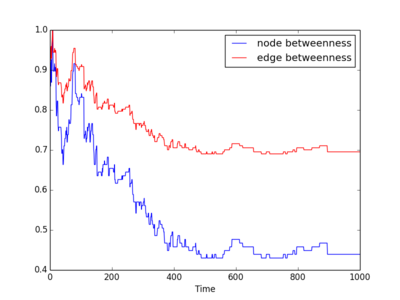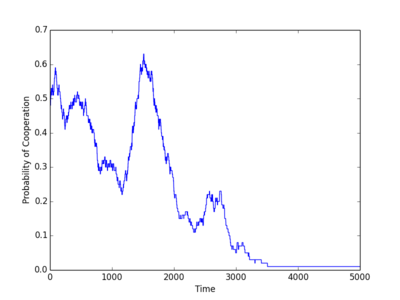Network Tolerance Page: Difference between revisions
From Santa Fe Institute Events Wiki
(Created page with '== Members == Jessica Santana jsant@stanford.edu <br> Junjian Qi <br> Claire (lagesse.claire at gmail.com) <br> Alireza (alireza.goudarzi at gmail.com) <br> Ali Kharrazi <br> =…') |
|||
| (15 intermediate revisions by 3 users not shown) | |||
| Line 1: | Line 1: | ||
= Summary = | |||
We are interested in studying the robustness of network with respect to its function and structure. Specifically, we would like to investigate the effect of perturbations of network structure on its function and dynamics. | |||
= Objective = | |||
= Deliverables = | |||
= Logistics = | |||
== Members == | == Members == | ||
Jessica Santana jsant@stanford.edu <br> | |||
Junjian Qi <br> | Jessica Santana (jsant@stanford.edu) : sociology<br> | ||
Claire (lagesse.claire at gmail.com) <br> | Junjian Qi (junjian.qi.2012@ieee.org) : power systems<br> | ||
Alireza (alireza.goudarzi at gmail.com) <br> | Claire (lagesse.claire at gmail.com) : geomatician<br> | ||
Ali Kharrazi <br> | Alireza (alireza.goudarzi at gmail.com) : computer scientist<br> | ||
Ali Kharrazi (ali@pp.u-tokyo.ac.jp) : sustainability science<br> | |||
Alex B (brummera@email.arizona.edu) : physics & ecology <br> | |||
Stefan Pfenninger (s.pfenninger12@imperial.ac.uk) : environmental science <br> | |||
Cecilia (ci.andreazzi@gmail.com) : ecology <br> | |||
Jennifer Hellmann (hellmann.13@osu.edu) <br> | |||
Beth (lusc0006@umn.edu) <br> | |||
Shai Gorsky (shai.gorsky@utah.edu) <br> | |||
== Meetings == | == Meetings == | ||
(1) <b style='color:red'>[DONE]</b> Friday, June 13, 2014 | |||
- Agenda: Define the topic | |||
-- We will study the robustness of dynamics/function of network with respect to changes or perturbations in the structure of the network. | |||
- Goal for next meeting: | |||
-- Each group member look for interesting example of robustness in their field and discuss it. | |||
(2) Monday, June 16, 2014 | |||
- Agenda: Discussion of examples of robustness in different disciplines. | |||
- Goal: define the scope of the project and decide on the model. | |||
(3) Wednesday, June 18, 2014 | |||
- Agenda: Discussion of sandpile model. | |||
- Goal: Define parameters of interest in sandpile model. | |||
= Files = | |||
== Ideas: Working draft == | |||
'''Claire: Failure Tolerance in Networks - What about the road network ?''' | |||
Let's picture a road network where nodes are roads and edges the intersections between roads. We can apply to each node a weight, given (for instance) to the length of the road it is representing. Thus, to go from one node to the other, there is a shortest path, witch minimize the number of nodes crossed. We can adjust this shortest path for it to take into account the weight of the node. So maybe it will readjust itself, crossing more nodes but with a minimal weight. | |||
If we want to consider the local tolerance of the network, we can increase gradually the weight of one node (randomly chosen - or not), as if the energy needed to cross this node is gradually more and more important. Then we can quantify the point where the shortest path is readjusting itself to prefer another node from the first one. This could quantify the tolerance of this node on the network. | |||
On a more global approach, if we calculate all the shortest paths of the network it will give us the betweeness of each node. We can see how this betweeness is readjusting on the whole network when the weight of a central node is increasing. It would be interesting to point the critical values for a given network. | |||
In this way, it would be possible to characterize the tolerance of a network to an increase weight perturbation on nodes given on its topology. | |||
'''Jessica: Failure Tolerance in Networks - Antibiotic Resistance''' | |||
Bacterial resistance to antibiotics is a serious public health and policy concern. Antibiotic resistance occurs at the bacterial population level via horizontal gene transfer, wherein resistant genes are transferred to susceptible bacteria. Through natural selection, the resistant bacteria come to dominate the bacterial population. Antibiotic resistance initially develops within a bacterium through genomic mutation. Resistant mutations are driven by exposure to the offending antibiotic. (http://en.wikipedia.org/wiki/Antibiotic_resistance) | |||
Genetic mutation leading to antibiotic resistance is an example of network tolerance of failure. | |||
Here the network could be either 1) the transfer of genes from one bacterium to another, or 2) it could be the DNA of the bacteria. Failure in network type 1 could be defined as the presence of the antibiotic. Failure in network type 2 could be the genetic mutation of the bacterium, which leads to antibiotic resistance. | |||
Given a damaging relationship, such as genetic mutation or antibiotic exposure, why would a network actor not switch to a healthier alternative? Are there switching costs in such biological networks? Does dependence of actor A on actor B increase or decrease the rate of “failure tolerance” in these networks? | |||
== Software Features == | |||
'''Existing Features''' | |||
(1) Creation of directed weighted graphs | |||
(2) definition of a process on a graph: each node state updates itself according to some generic rule | |||
(3) structural perturbations: the edge weights can fluctuate and be deleted or rewired between a new pair of nodes. | |||
'''To be added''' | |||
Hopefully we will have some stuff here as we narrow down are study | |||
== Preliminary Results == | |||
'''Changes in the average node betweenness and edge betweenness centrality measures'''<br> | |||
This example shows the we can measure structural properties of the network as it undergoes perturbations. <br> | |||
[[File:betweennessPerturbation.png|400px]] | |||
'''Changes in the number of cooperators as the nodes play games'''<br> | |||
This example shows the we can calculate a measure of dynamics of the process running of the network.<br> | |||
[[File:pdf1.png|400px]] | |||
Latest revision as of 16:10, 18 June 2014
Summary
We are interested in studying the robustness of network with respect to its function and structure. Specifically, we would like to investigate the effect of perturbations of network structure on its function and dynamics.
Objective
Deliverables
Logistics
Members
Jessica Santana (jsant@stanford.edu) : sociology
Junjian Qi (junjian.qi.2012@ieee.org) : power systems
Claire (lagesse.claire at gmail.com) : geomatician
Alireza (alireza.goudarzi at gmail.com) : computer scientist
Ali Kharrazi (ali@pp.u-tokyo.ac.jp) : sustainability science
Alex B (brummera@email.arizona.edu) : physics & ecology
Stefan Pfenninger (s.pfenninger12@imperial.ac.uk) : environmental science
Cecilia (ci.andreazzi@gmail.com) : ecology
Jennifer Hellmann (hellmann.13@osu.edu)
Beth (lusc0006@umn.edu)
Shai Gorsky (shai.gorsky@utah.edu)
Meetings
(1) [DONE] Friday, June 13, 2014 - Agenda: Define the topic -- We will study the robustness of dynamics/function of network with respect to changes or perturbations in the structure of the network. - Goal for next meeting: -- Each group member look for interesting example of robustness in their field and discuss it.
(2) Monday, June 16, 2014 - Agenda: Discussion of examples of robustness in different disciplines. - Goal: define the scope of the project and decide on the model.
(3) Wednesday, June 18, 2014 - Agenda: Discussion of sandpile model. - Goal: Define parameters of interest in sandpile model.
Files
Ideas: Working draft
Claire: Failure Tolerance in Networks - What about the road network ?
Let's picture a road network where nodes are roads and edges the intersections between roads. We can apply to each node a weight, given (for instance) to the length of the road it is representing. Thus, to go from one node to the other, there is a shortest path, witch minimize the number of nodes crossed. We can adjust this shortest path for it to take into account the weight of the node. So maybe it will readjust itself, crossing more nodes but with a minimal weight.
If we want to consider the local tolerance of the network, we can increase gradually the weight of one node (randomly chosen - or not), as if the energy needed to cross this node is gradually more and more important. Then we can quantify the point where the shortest path is readjusting itself to prefer another node from the first one. This could quantify the tolerance of this node on the network.
On a more global approach, if we calculate all the shortest paths of the network it will give us the betweeness of each node. We can see how this betweeness is readjusting on the whole network when the weight of a central node is increasing. It would be interesting to point the critical values for a given network.
In this way, it would be possible to characterize the tolerance of a network to an increase weight perturbation on nodes given on its topology.
Jessica: Failure Tolerance in Networks - Antibiotic Resistance
Bacterial resistance to antibiotics is a serious public health and policy concern. Antibiotic resistance occurs at the bacterial population level via horizontal gene transfer, wherein resistant genes are transferred to susceptible bacteria. Through natural selection, the resistant bacteria come to dominate the bacterial population. Antibiotic resistance initially develops within a bacterium through genomic mutation. Resistant mutations are driven by exposure to the offending antibiotic. (http://en.wikipedia.org/wiki/Antibiotic_resistance)
Genetic mutation leading to antibiotic resistance is an example of network tolerance of failure.
Here the network could be either 1) the transfer of genes from one bacterium to another, or 2) it could be the DNA of the bacteria. Failure in network type 1 could be defined as the presence of the antibiotic. Failure in network type 2 could be the genetic mutation of the bacterium, which leads to antibiotic resistance.
Given a damaging relationship, such as genetic mutation or antibiotic exposure, why would a network actor not switch to a healthier alternative? Are there switching costs in such biological networks? Does dependence of actor A on actor B increase or decrease the rate of “failure tolerance” in these networks?
Software Features
Existing Features (1) Creation of directed weighted graphs (2) definition of a process on a graph: each node state updates itself according to some generic rule (3) structural perturbations: the edge weights can fluctuate and be deleted or rewired between a new pair of nodes. To be added Hopefully we will have some stuff here as we narrow down are study
Preliminary Results
Changes in the average node betweenness and edge betweenness centrality measures
This example shows the we can measure structural properties of the network as it undergoes perturbations.

Changes in the number of cooperators as the nodes play games
This example shows the we can calculate a measure of dynamics of the process running of the network.

